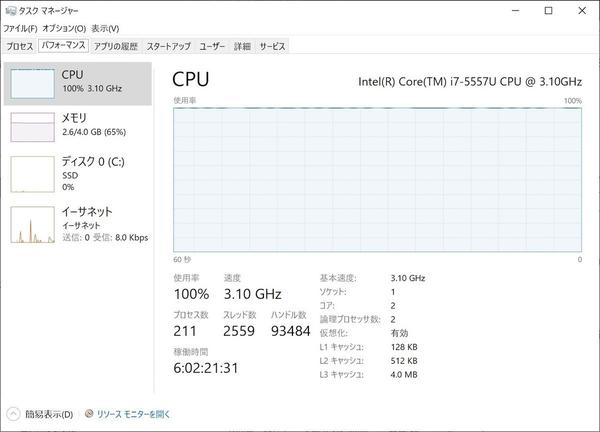What to do when Windows 10 CPU usag...
02
04
What to do when Windows 10 CPU usage rate stays at 100%
You can try restarting your PC first, but there are still things you can do before restarting. Based on the article "100% CPU Usage in Windows 10? Here's How to Fix it - Make Tech Easier" on maketechesier.com, let's introduce what to do when CPU usage reaches 100% in Windows 10. .
Check WMI processes
One of the core services in Windows 10 is WMI (Windows Management Instrumentation). WMI is a system interface for managing Windows systems, and performs various control tasks related to the OS, such as acquiring system status and setting various parameters. Since this is an important service, it is not recommended to disable it easily, but sometimes this process can occupy CPU resources, so if WMI is the cause of the high CPU usage, restart the WMI service. You may be able to solve the problem by doing
So, go to Task Manager's Processes tab and look for "Service Host: Windows Management Instrumentation" to see its CPU usage.
Nothing is wrong with the picture above, but if the CPU usage of this process is close to 100% and doesn't go down, you can try restarting the WMI service.
Windows services are managed using the "Services" app. The service app is located in the "Windows Administrative Tools" folder in the list of apps in the start menu. After launching the Services app, search for "Windows Management Instrumentation" in the list of services, right-click on it and click Restart to restart the service.
If restarting the service does not improve the problem, you may be able to find the cause by checking the event log. Use the "Event Viewer" app to check the event log. The Event Viewer app is included in the Start menu's Windows Administrative Tools folder, just like the Services app.
After starting Event Viewer, go to [Applications and Services Logs]->[Microsoft]->[Microsoft]->[Windows]->[WMI-Activity] from the tree on the left and select [Operational]. The middle "Operational" window shows all the processes that the WMI service is handling. A process whose label is "error" indicates that some kind of error has occurred. Next, select the process in error and check the "Client Process ID" number from the "General" tab display in the window below. This is the process id that is causing the error.
Once you know the process ID, go back to Task Manager and look for the corresponding process in the "PID" item on the "Details" tab. If that process is the cause of the high CPU usage, right-click and click Open File Location to display the folder of the program that started the process in Explorer. Since the program that caused the problem can be identified, the next action, such as disabling, updating, or reinstalling the program, can be considered.
Disable SysMain service
The suggested next step is to disable the "SysMain" service. The SysMain service was formerly known as "Superfetch" and is also described as Superfetch on maketecheasier.com. SysMain is a service that allows Windows to learn frequently used apps and preload them into memory to speed up startup. SysMain is a useful service, but it is known to have occasional issues on older devices and waste CPU resources.
First, let's check the CPU usage of the SysMain service in Task Manager, just like with WMI. If the process of "Service Host: SysMain" has high CPU usage, you may be able to improve the situation by clicking [Stop Task] in the right-click menu to terminate the process.

If you want to keep the SysMain service disabled even after restarting your PC, search for "SysMain" in the Services app as shown below and select [Properties] from the right-click menu.
And set the "Startup type" item in the Properties window to [Disabled].
By the way, even if a Windows service other than WMI or SysMain is the cause of the increase in CPU usage, you can identify the cause and deal with it in the same way. However, some services are essential for Windows to work properly, so be careful when disabling them.
Set Power Options to Balanced
In addition, setting the power option to "balanced" is mentioned as a means to eliminate 100% CPU usage. If the power option is set to "high performance", the CPU may be overloaded on older devices. In particular, it is said that it is likely to occur when the plan setting is changed independently.
Power options can be set in the Control Panel. The Control Panel is located in the "Windows System Tools" folder in the list of apps in the Start menu. After opening the Control Panel, change the "View by" to [Large Icons] or [Small Icons] and click the [Power Options] icon to change the power options settings.
Here, you can set it to [Balanced (recommended)] as follows. In addition, it is safe to reset the plan settings to the default values with "Change plan settings".
Check for power failure
In some cases, the CPU may be overloaded due to a faulty power supply rather than a software problem. If the voltage is insufficient, the CPU can only demonstrate a part of its performance, resulting in insufficient CPU power and increased utilization.
For laptops, unplug the power cable and run it on battery, then click the power button on the taskbar and set the power mode to "Best Performance". If the battery isn't the problem, but the power supply is the problem, this setting might return CPU usage to normal.
If you want to check the failure of the power supply on a desktop PC, you need to open the case of the main unit and physically replace the power supply and test it.
Disable third-party antivirus software
In some cases, third-party antivirus software puts a high load on the CPU. In general, when a full virus scan is in progress, CPU usage will increase, so in that case, reschedule the scan so that it doesn't affect your normal work.
If your antivirus software overloads your CPU for a long time and doesn't recover, you can try disabling your antivirus software and check. Windows comes with Windows Defender by default, so with Windows Defender enabled, disabling third-party antivirus software is almost never a security concern. If your antivirus software turns out to be causing the CPU overload, it's a good idea to stop using it and consider moving to Windows Defender or other software.
Summary
High CPU usage not only slows down your PC, but it can also cause your CPU to run extremely hot. It is known that if the CPU temperature continues to be high on a daily basis, the life of the CPU tends to be shortened. In order to prolong the life of your PC, pay attention to the load status of the CPU, and if the usage rate is unnaturally high, refer to the above and deal with it.







